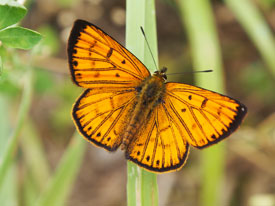Bringing in the Copper butterflies
Let’s plant a Copper Butterfly highway.
Many moons ago when I was a child, our NZ Common Copper butterflies were numerous and I would see them almost every day in central Wellington where I grew up. Now I get very excited if I see a Common Copper in my urban Palmerston North garden, and I have chased a few away with my sheer enthusiasm to keep their company. It was after one such session of chasing a copper butterfly around the garden, camera in hand, that I made the decision to plant far more host plants for their larvae, in the hope that I would see so many copper butterflies, that I would no longer feel compelled to harass each individual upon it’s arrival and would hopefully become blasé about them.
Muehlenbeckia is the host plant of our Copper butterfly group, and there is surely room in every garden to plant at least one. Most of our New Zealand Copper butterflies don’t travel more than 50 metres or so from their host plants, so we ALL need to plant one or two Muehlenbeckia in order to make a Copper butterfly highway that stretches from beach and forest to car-park and townhouse. Even if you live in an apartment with no garden at all, you may have a tiny balcony on which you can put a pot of Muehlenbeckia.
I had planted a large Muehlenbeckia astonii on our back section purely because it was on my top ten all time favourite plants. I love its cloud-like fluffy appearance when mature, and can’t resist its quirky angular purplish stems seen at their best in winter when most of the leaves vanish. This plant has the most endearing small green heart shaped leaves. Its tiny almost insignificant flowers are followed by tiny white fruits that are delicious if you have the patience to collect some. M. astonii is native to the Cook Strait area where it grows in wind-blown tight mounds that resist all the salt-laden foul gales that the straits can throw at them. If it can grow in Cook Strait it can grow at your place. Looking for a tough wind hardy hedge to shelter other plants? This is it!
M. axillaris is a dense groundcover with wiry stems and tiny dark green leaves. Commonly called Pohuehue, or wire vine, M. axillaris will flower profusely during summer with masses of tiny cream flowers followed by loads of small white opaque fruit. It spreads along the ground forming a dense groundcover which makes an excellent green carpet. This is a semi-vigorous grower and will cover a couple of metres of ground in a few short years forming a lovely low dense mat on which you can show off other plants to best effect.
Although Muehlenbeckia is found naturally in dry riverbeds and rocky areas in the South Island and lower North Island it will grow in nearly all urban garden situations throughout the country that get some sun, and will even thrive in a pot. It is not fussy about great soil and will grow in your poorest ground.
M. complexa is a more vigorous and adventurous vine which will scramble up walls and down banks and if you have a difficult area to cover this plant might be your best friend.
If you want to bring some Copper butterflies into your garden, then get planting this interesting group of plants and let’s try and make Common Coppers, once again ‘common’ in town. A search on the website of the Moths and Butterflies of NZ Trust will bring many other ideas.
Written by Jane Carver for Moths and Butterflies of New Zealand Trust. For more information about Butterflies or to become a MBNZT member pleases visit www.nzbutterflies.org.nz.
Image © Angela Moon-Jones.
4-May-2014

Common Copper butterfly

